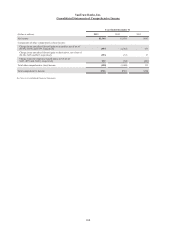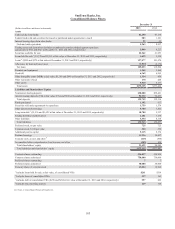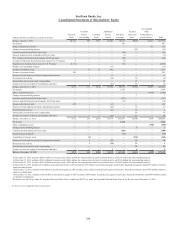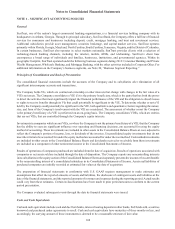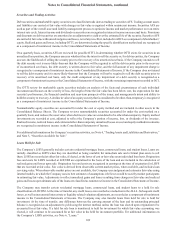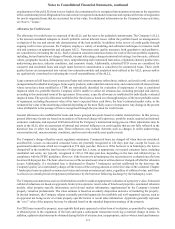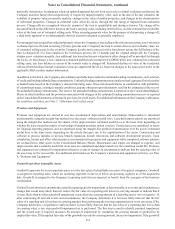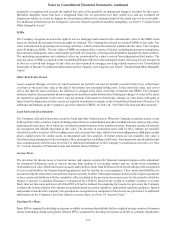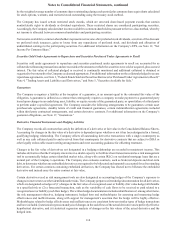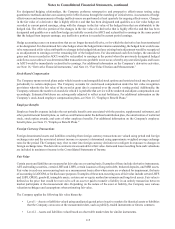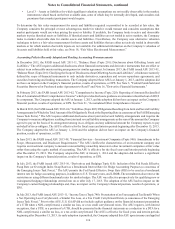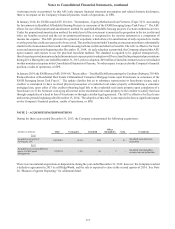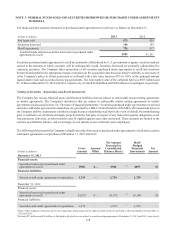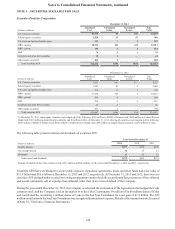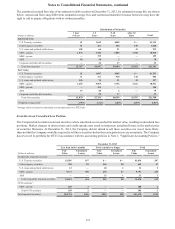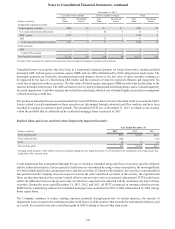SunTrust 2013 Annual Report Download - page 128
Download and view the complete annual report
Please find page 128 of the 2013 SunTrust annual report below. You can navigate through the pages in the report by either clicking on the pages listed below, or by using the keyword search tool below to find specific information within the annual report.Notes to Consolidated Financial Statements, continued
112
materially deteriorates. In situations where an updated appraisal has not been received or a formal evaluation performed, the
Company monitors factors that can positively or negatively impact property value, such as the date of the last valuation, the
volatility of property values in specific markets, changes in the value of similar properties, and changes in the characteristics
of individual properties. Changes in collateral value affect the ALLL through the risk rating or impaired loan evaluation
process. Charge-offs are recognized when the amount of the loss is quantifiable and timing is known. The charge-off is
measured based on the difference between the loan’s carrying value, including deferred fees, and the estimated net realizable
value of the loan, net of estimated selling costs. When assessing property value for the purpose of determining a charge-off,
a third party appraisal or an independently derived internal evaluation is generally employed.
For mortgage loans secured by residential property where the Company is proceeding with a foreclosure action, a new valuation
is obtained prior to the loan becoming 180 days past due and, if required, the loan is written down to net realizable value, net
of estimated selling costs. In the event the Company decides not to proceed with a foreclosure action, the full balance of the
loan is charged-off. If a loan remains in the foreclosure process for 12 months past the original charge-off, the Company
obtains a new valuation annually. Any additional loss based on the new valuation is either charged-off or provided for through
the ALLL. At foreclosure, a new valuation is obtained and the loan is transferred to OREO at the new valuation less estimated
selling costs; any loan balance in excess of the transfer value is charged-off. Estimated declines in value of the residential
collateral between these formal evaluation events are captured in the ALLL based on changes in the house price index in the
applicable MSA or other market information.
In addition to the ALLL, the Company also estimates probable losses related to unfunded lending commitments, such as letters
of credit and binding unfunded loan commitments. Unfunded lending commitments are analyzed and segregated by risk similar
to funded loans based on the Company’s internal risk rating scale. These risk classifications, in combination with probability
of commitment usage, existing economic conditions, and any other pertinent information, result in the estimation of the reserve
for unfunded lending commitments. The reserve for unfunded lending commitments is reported on the Consolidated Balance
Sheets in other liabilities and the provision associated with changes in the unfunded lending commitment reserve is reported
in the Consolidated Statements of Income in provision for credit losses. For additional information on the Company's allowance
for credit loss activities, see Note 7, “Allowance for Credit Losses.”
Premises and Equipment
Premises and equipment are carried at cost less accumulated depreciation and amortization. Depreciation is calculated
predominantly using the straight-line method over the assets’ estimated useful lives. Leasehold improvements are amortized
using the straight-line method over the shorter of the improvements’ estimated useful lives or the lease term, depending on
whether the lease meets the transfer of ownership or bargain-purchase option criterion. Certain leases are capitalized as assets
for financial reporting purposes and are amortized using the straight-line method of amortization over the assets’ estimated
useful lives or the lease terms, depending on the criteria that gave rise to the capitalization of the assets. Construction and
software in process includes in process branch expansion, branch renovation, and software development projects. Upon
completion, branch and office related projects are maintained in premises and equipment while completed software projects
are reclassified to other assets in the Consolidated Balance Sheets. Maintenance and repairs are charged to expense, and
improvements that extend the useful life of an asset are capitalized and depreciated over the remaining useful life. Premises
and equipment are evaluated for impairment whenever events or changes in circumstances indicate that the carrying value of
the asset may not be recoverable. For additional information on the Company’s premises and equipment activities, see Note
8, “Premises and Equipment.”
Goodwill and Other Intangible Assets
Goodwill represents the excess purchase price over the fair value of identifiable net assets of acquired companies. Goodwill
is assigned to reporting units, which are operating segments or one level below an operating segment, as of the acquisition
date. Goodwill is assigned to the Company’s reporting units that are expected to benefit from the synergies of the business
combination.
Goodwill is not amortized and instead is tested by reporting unit for impairment, at least annually, or as events and circumstances
change that would more likely than not reduce the fair value of a reporting unit below its carrying amount or indicate that it
is more likely than not that a goodwill impairment exists when the carrying amount of a reporting unit is zero or negative. If,
after considering all relevant events and circumstances, the Company determines it is not more likely than not that the fair
value of a reporting unit is less than its carrying amount, then performing the two step impairment test is not necessary. If the
Company determines via qualitative analysis that it is more likely than not that the fair value of a reporting unit is less than
its carrying value, a two step goodwill impairment test is performed. The first step is used to identify potential impairment
and the second step, if required, measures the amount of impairment by comparing the carrying amount of goodwill to its
implied fair value. If the implied fair value of the goodwill exceeds the carrying amount, there is no impairment. If the goodwill




